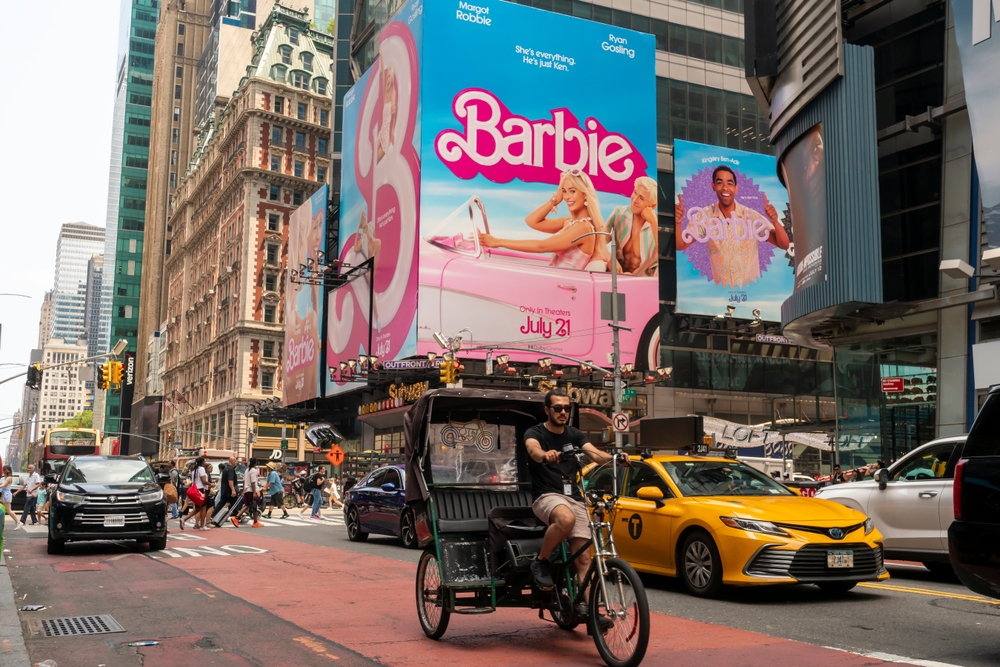Following the epic press tour for the highly anticipated Hollywood movie, Barbie was released in cinemas last week. The Barbie doll has been coined a ‘cultural artefact’, ‘a classic kidult brand’, and social icon since the mid twentieth century. Barbie and manufacturer Mattell has not had an easy ride, having been criticised for being behind the times, promoting unhealthy body types and white-washed beauty ideals. Though the 2023 film has claimed a step towards a more ‘diverse’ Barbie, it remains unclear whether this is the case.
With Margot Robbie and Ryan Gosling as lead actors of the “original” Barbie on our screens, they visually represent the slim, white, blonde doll that was created by Ruth Handler in 1959. Whilst Barbie’s distinctively arched feet, large head and slim waist has been criticised for the unattainable beauty standards that have permeated cultural norms, the Barbie brand has moved with the times as Mattel has produced dolls with different skin colours, abilities and shapes in recent years. Mattell now pride themselves “the most diverse doll line” with 35 skin tones, 97 hairstyles and 9 body types represented in their current collection.
Diverse Dolls
It was in 1968 that Mattell released their first Black doll, and in 1980 that their Black and Hispanic dolls were named “Barbie” for the first time.
This has enabled a wider range of children to see and play with dolls that look like them.
Not only are the dolls now visually more diverse, they also strive for the dolls to be represented in male-dominated careers. The 2023 film has sought to embrace the more forward-thinking aspects of the Barbie brand, with film director Greta Gerwig stating:
“The kind of amazing thing is that Barbie went to the moon before women had the ability to get credit cards… That’s crazy. She was always a kind of step ahead.”
The Barbie film has also sought to embrace a more diverse approach, with director Gerwig claiming it is a celebration of “the real life Barbie”. From “president” Barbie played by actress Issa Rae and other ethnically diverse castings of Ken and Barbie including: Ncuti Gatwa, Ramzan Miah, Alexandra Shipp and Ritu Arya. Issa Rae reflected on the positive influence Black Barbie had on her racial identity and career aspirations, stating:
“My mom was super intentional about making sure I had a Black Barbie, and I think it made me realize that I was Black as a kid… It was another step on the ladder of my journey with my racial identity, just because I saw how passionate my parents were about me playing with Black Barbies, though I didn’t know it was that serious.. I was just there trying to make scenes with my Barbies. And I think in some ways, that was my first foray into storytelling and directing.”
It is apparent that Barbie the movie is taking steps to ensure everyone can identify with the culturally symbolic brand. Many are celebrating this triumphant step forward for traditionally white-dominated popular culture. Though, as Robbie and Gosling remain the figureheads for the film, many remain sceptical over how authentic this representation truly is.
How can we ensure representation is authentic, not tokenistic?
How can authentic representation lead to positive change?
Like the Barbie brand, many organisations are evolving to create a more diverse and inclusive environment. The brand has been praised for its resilience by the Financial Times as a brand “that keeps changing with the times”, however this is not the case for many other organisations and workplaces.
How authentic is representation in the workplace?
Research continues to indicate that representation is improving but more can still be done to ensure it is authentic and bringing about cultural change and senses of belonging, not simply tick-box figures.
A survey with over 2000 senior leaders in 2022 by CIPD found that only 38% of employers claim to collect some kind of equal opportunities monitoring data. Furthermore, only 31% of respondents felt their organisation was above average in inclusivity compared to their competitors and wider industry.
Whilst the updated 2023 Parker Review praised the “significant changes” to ethnically diverse boardroom representation, as 96% of FTSE 100 companies had at least one director from an ethnically diverse background on their board, many feel this representation is not felt in the culture of their workplace.
When employees are surveyed instead, the results are often less optimistic. Such as the Equality, Diversity and Inclusivity in the Workplace Survey conducted in 133 UK workplaces that found a fifth of employees don’t feel their organisation is an inclusive place to work, with 57% of employees having experienced discrimination or a lack of inclusivity.
It is clear that even if workplaces are deemed to have good representation, authentic representation is when this seeps into culture and values. This inclusive ethos within an organisation is good for business, as coined by management thinker Peter Drucker that “Culture eats strategy for breakfast”.
Therefore- as a step towards inclusion has been good for the Barbie brand and its consumers, greater representation can be good for your organisation and employees too.
As film reviews begin following the release on July 21st 2023, the true test of representation that the film and brand have claimed will become apparent for all in the upcoming days and weeks.
Would your organisation stand the test of authentic representation?
Does everyone feel they ‘belong’ in your workplace?
We would value your thoughts, please do follow us and join the conversation on LinkedIn
If you want to see change and race equality in the workplace, join the Race Equality Matters’ movement if you are not registered already.
Register here.
Image Shutterstock

